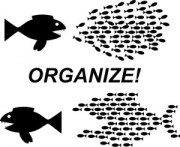 What kind of businesses do unions approach to organize workers? Much is known about what happens to a business after it becomes unionized. But there is little information on where the threat of union formation is highest, and where union activity is most concentrated. Do unions mainly try to organize big and profitable business establishments? These establishments can provide larger employment and benefits to the union. However, they may also be harder for unions to organize, because in general they have higher wages, as well as greater resources and better management to resist unionization.
What kind of businesses do unions approach to organize workers? Much is known about what happens to a business after it becomes unionized. But there is little information on where the threat of union formation is highest, and where union activity is most concentrated. Do unions mainly try to organize big and profitable business establishments? These establishments can provide larger employment and benefits to the union. However, they may also be harder for unions to organize, because in general they have higher wages, as well as greater resources and better management to resist unionization.
Alternatively, unions may more frequently focus on smaller or medium-sized establishments that may be easier to organize because of poorer labor conditions and weak management. These establishments also offer lower wages and benefits in general, potentially implying a higher demand for unionization.As to the timing of union activity, when in an establishment’s life cycle does a union try to organize it? Does a union emerge in a business when the business is young, or later when it is more established? Such timing can matter for the survival and growth prospects of an establishment, if a union is successful in extracting surplus from a young establishment in the early stages of growth.
A new IZA discussion paper by Emin Dinlersoz, Jeremy Greenwood, and Henry Hyatt explores the union organizing process in the US. They offer a model of union learning in which a union gradually gathers information about the productivity of a business and decides whether to organize its employees at some point in time.
The model predicts that unions target large and productive establishments early on in their life cycles. To see the relevance of these predictions, the authors assemble a new, comprehensive panel data on union activity at the establishment level for the period 1977-2007. The data allows tracking of union activity in an establishment starting from its birth until exit, making it possible to identify when exactly a union election occurs in an establishment’s lifetime.
The analysis of data reveals that unions are indeed much more likely to target and successfully organize larger, more productive, and younger businesses. For example, in manufacturing a large plant with 500 or more employees is about 25 times more likely to be targeted by a union for organizing purposes, compared to a small plant with less than 10 employees.Furthermore, unions do not wait too long to target a large and productive establishment after it is born. The youngest group of establishments (0-3 years old) is approximately twice as likely to be targeted as the oldest group (25+ years old).
Given that unions generally target, and successfully organize, large, productive firms in the U.S. economy, any effects of unions on business outcomes may be larger than previously thought, as these establishments account for the bulk of economic activity. First, the disproportionate presence of the mere threat of union targeting in these establishments can have larger welfare consequences. For instance, these establishments may have to raise wages and devote more resources to resist unionization.Second, the concentration of successful union organizing in these establishments means that post-unionization effects can be more prevalent in the larger and more productive segment of the establishments. If unions indeed have large adverse effects on businesses, this prevalence has important consequences.